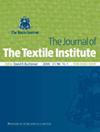Regression model for predicting the air resistance of fabric made from doubled yarns and with different weave structures
IF 1.5
4区 工程技术
Q2 MATERIALS SCIENCE, TEXTILES
引用次数: 0
Abstract
The purpose of the investigation is to model the effect of doubled yarns produced from conventional and compact yarns in three different combinations and weave structures on the air resistance of fabrics. A series of woven fabrics differing only in weave structures and having the common count and fabric sett was produced from three types of doubled yarns, namely compact/compact, conventional/conventional and compact/conventional. The hybrid combination was produced principally to reduce the cost of manufacturing doubled yarns. Essential data for the fabrics such as CFF (crossing over firmness factor), FYF (floating yarn factor), FFF (fabric firmness factor), mass per unit area, thickness and porosity were determined. Air resistance was determined by performing the standard test KES-F8 API. Analysis of the results in respect of fabrics produced from the compact/compact, conventional/conventional and conventional/compact yarns shows a strong correlation between the air resistance, porosity, CFF, FYF, FFF, mass per unit area and thickness (R = conventional/conventional 0.97, compact/compact 0.861, conventional/compact 0.974) and the generated statistical models have given the satisfactory prediction of air resistance. Among the parameters, thickness exerts a strong influence on the air resistance. It is concluded that in order to predict air resistance, a number of parameters are needed and any conclusion which has been drawn using only CFF and FYF should be treated with caution. Also the possibility of cost saving as a result of using hybrid doubled yarn has been pointed out.不同组织结构双纱织物空气阻力预测的回归模型
本研究的目的是模拟由常规纱线和紧实纱线在三种不同的组合和组织结构下生产的双重纱线对织物空气阻力的影响。用三种类型的双捻纱,即紧捻/紧捻、常规/常规和紧捻/常规,生产了一系列机织物,它们只是在组织结构上有所不同,并且具有相同的支数和织物密度。生产混纺纱主要是为了降低生产双纺纱的成本。测定了织物的交叉紧度系数(CFF)、浮纱系数(FYF)、织物紧度系数(FFF)、单位面积质量、厚度和孔隙率等基本数据。通过执行标准测试KES-F8 API来确定空气阻力。对致密/致密、常规/常规和常规/致密纱线织物的分析结果表明,空气阻力、孔隙率、CFF、FYF、FFF、单位面积质量和厚度之间存在较强的相关性(R =常规/常规0.97,致密/致密0.861,常规/致密0.974),所建立的统计模型对空气阻力的预测结果令人满意。其中,厚度对空气阻力的影响较大。结论是,为了预测空气阻力,需要许多参数,并且仅使用CFF和FYF得出的任何结论都应谨慎对待。并指出了采用混纺双纱节约成本的可能性。
本文章由计算机程序翻译,如有差异,请以英文原文为准。
求助全文
约1分钟内获得全文
求助全文
来源期刊

Journal of the Textile Institute
工程技术-材料科学:纺织
CiteScore
4.20
自引率
5.90%
发文量
149
审稿时长
1.0 months
期刊介绍:
The Journal of The Textile Institute welcomes papers concerning research and innovation, reflecting the professional interests of the Textile Institute in science, engineering, economics, management and design related to the textile industry and the use of fibres in consumer and engineering applications. Papers may encompass anything in the range of textile activities, from fibre production through textile processes and machines, to the design, marketing and use of products. Papers may also report fundamental theoretical or experimental investigations, including materials science topics in nanotechnology and smart materials, practical or commercial industrial studies and may relate to technical, economic, aesthetic, social or historical aspects of textiles and the textile industry.
All published research articles in The Journal of The Textile Institute have undergone rigorous peer review, based on initial editor screening and anonymized refereeing by two expert referees.
 求助内容:
求助内容: 应助结果提醒方式:
应助结果提醒方式:


